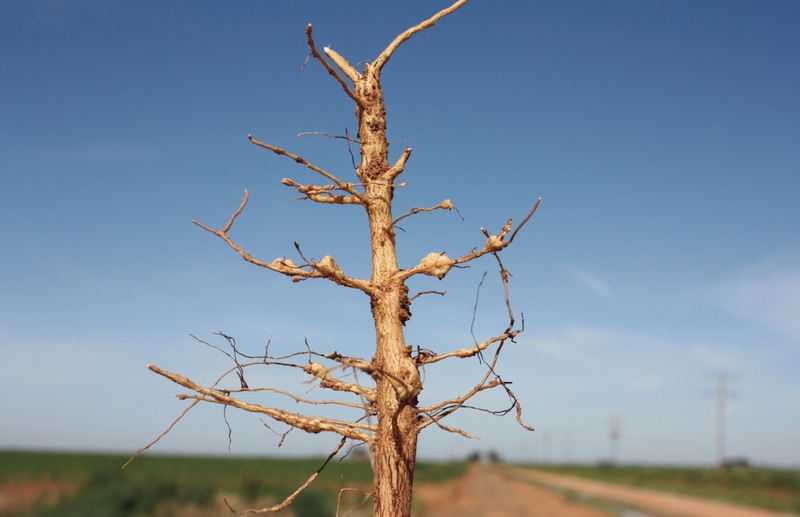Keeping Texas Weed Pests Under Control
Carelessweed. Pigweed. Palmer amaranth. Call it what you will, but it has been an ever-growing thorn in the side of cotton growers from the Southeast into the Southwest for years. It’s one of the reasons growers were excited to add the new dicamba traits and corresponding products to their weed control programs.
In 2017, they were finally able to take full advantage of the dicamba system. And Texas growers jumped at the opportunity.
“If you were able to go back and look at a typical cotton field out here 2-3 years ago, there was a lot of escaped pigweed,” says Dr. Wayne Keeling, AgriLife Extension weed specialist, based in Lubbock. “People were really struggling for ways to achieve effective control, even after they had gone back to using a pretty wide range of residuals. But that just wasn’t enough.
“What we saw area-wide in 2017 was just really effective weed control,” he continues. “The majority of the acres here were planted to dicamba-tolerant varieties. Growers were very effective in managing the technology and controlling weeds. That’s not to say there weren’t some situations where weeds were too big or something wasn’t done exactly right and control wasn’t as good as people hoped for. But overall, it was a successful year in terms of the overall level of weed control achieved and minimal off-site target problems.”
Off-target issues in the Mid-South and parts of the Midwest dominated headlines throughout the 2017 growing season, prompting several states to temporarily stop use of the new dicamba products until they could put new guidelines in place for in-crop applications. The EPA – in conjunction with Monsanto, DuPont and BASF – stepped up later in the year with new restrictions and label clarifications aimed to protect growers and the much-needed technology moving into 2018.
Keeling says any issues in Texas were minimal.
“From a personal standpoint, I did not look at or hear of any problems,” he says. “That’s not to say they didn’t exist, but there were very few reported to the Texas Department of Agriculture, and some may have been resolved by neighbors.
“But, we just don’t have a lot of soybeans out here, which makes life a lot simpler. If your neighbors all have dicamba-tolerant cotton, it’s hard to have problems. However, people do need to be vigilant and take advantage of the training to be sure they’re doing things right.
Based on his observations, Keeling says, overall, weather during the growing season allowed growers to be timely with their applications. Most used residuals as recommended and didn’t have to struggle with high weed populations. He acknowledges that some growers may have waited a bit too long and had to play a little catch up with their spraying, but most were simply going after escapes.
“With big rigs, people can cover a lot of acres,” he points out, “and overall, they did a good job. But we need to remember that we can use the best residuals and still have some escapes. To me, that’s where the new technologies such as XtendFlex are so important to get those last few weeds that residuals can’t control.”
As part of their revised guidelines, EPA has now classified dicamba as a Restricted Use Pesticide nationwide, is requiring record keeping of all applications for two years, and is making training and licensing mandatory for anyone – grower, farmhand, custom applicator – who applies auxin herbicides to any crop.
For Texas, those guidelines won’t require a lot of change for 2018. Dicamba was classified as a Restricted Use Pesticide by the state in 2017, so growers already have a year’s experience working under tighter requirements.
In 2017, growers in Texas who used the new dicamba products had to have a license and keep records,” says Keeling. “That’s going to be a big change in some states. In Texas, the training just reinforces what people have been told over the last 2-3 years as this label was awaiting introduction. There was lots of training from the universities, the companies, from distributors and such, making growers aware of what they needed to do to be successful.
“To me, it’s not really starting over,” he states. “It’s building on and reinforcing what’s been available before.”
Reports of adoption of dicamba-tolerant cotton varieties in 2017 are high across Texas, with Keeling estimating that 70-75% of acres in the High and Rolling Plains featured the technology. He can see some room for growth in 2018, but admits that there may be limits to adding acres when the current percentage is that high, especially when other varieties without the technology are still popular with growers.
“One of my big concerns is that we don’t go down the road of over-reliance on the dicamba products,” he says. “I think people learned a lesson with Roundup about over-relying on one chemical. And I think, as a whole, that people are incorporating dicamba into a program with other residuals. To me, that’s the key to maintaining the technology for an extended period so growers can be able to effectively control weeds five and ten years from now.
“For the first year with dicamba, weed control in Texas was effective, and problems were minimal. That’s as good as you can ask for.”
From Cotton Grower Special Texas Report – Winter 2018









